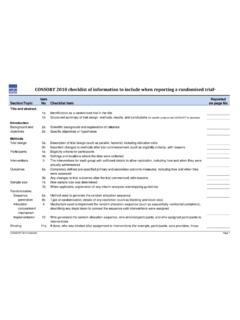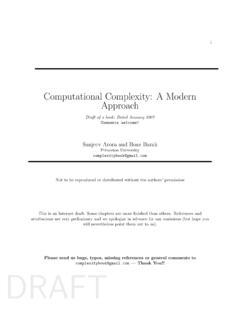Transcription of SUGI 27: Generating Randomization Schedules Using SAS(r ...
1 Paper 267-27 Generating Randomization Schedules Using SAS ProgrammingChunqin Deng and Julia Graz, PPD, Inc., Research Triangle Park, North CarolinaABSTRACTR andomization as a method of experimental control hasbeen extensively used in clinical trials. Generating therandomization schedule has been an essential part ofsome trials. We discuss how to use SAS programmingand SAS PROC PLAN to generate the randomizationschedule. The issues related to Randomization are alsodiscussed. Case studies are used to illustrate the use ofSAS programming and SAS PROC PLAN in generatingrandomization : Randomization Schedule, Clinical Trial,PROC PLANINTRODUCTIONR andomization as a method of experimental control hasbeen extensively used in clinical trials. The fundamentaloccasion for Randomization is the assignment oftreatment conditions to patients or, as preferred herein,assignment of patients to treatment tends to produce treatment groups inwhich the distributions of prognostic factors, known andunknown, are similar.
2 In combination with blinding, Randomization helps to avoid possible bias in theselection and allocation of patients arising from thepredictability of treatment assignments. From astatistical standpoint, Randomization provides forunbiased estimates of error variance and forindependence of practice, Randomization requires Generating therandomization Schedules which should be of a Randomization schedule usuallyincludes obtaining random numbers and assigningrandom numbers to patients or treatment numbers can be generated by computer orcan come from a random number table found in moststatistics textbooks. For some simple randomizedcontrolled trials with small sample sizes, randomizationcan be done easily by assigning random numbers froma random number table to the treatment conditions andtranslate the random number into the , if the sample sizes are large, or if a restrictedrandomization or stratified Randomization will beperformed, or if an unbalanced treatment allocationratio will be used, it is better for us to use computerprogramming to do the Randomization , BLOCKRANDOMIZATION, AND STRATIFIEDRANDOMIZATIONThe most elementary form of Randomization isunrestricted Randomization in which treatments areallocated to patients in sequence based on randomnumber without any restriction.
3 Although unrestrictedrandomization is an acceptable approach, someadvantages can generally be gained by randomizingpatients in blocks, which is usually called blockrandomization or restricted Randomization . Blockrandomization helps to increase the comparability of thetreatment groups, particularly when patientcharacteristics may change over time, as a result, forexample, of changes in recruitment policy. It alsoprovides a better guarantee that the treatment groupswill be of nearly equal size. In crossover trials itprovides the means of obtaining balanced designs withtheir greater efficiency and easier interpretation. Careshould be taken to choose block lengths that aresufficiently short to limit possible imbalance, but that arelong enough to avoid predictability towards the end ofthe sequence in a Randomization approach used in practice isstratified Randomization , in which separaterandomization lists are produced for each subgroup orstratum.
4 It is usually used for controlling the imbalanceof baseline characteristics such as gender, age group,or baseline condition. In multi-center clinical trials, Randomization can be conducted centrally or conductedat each center. This can be looked at as an example ofstratified Randomization with center as a stratum Randomization can also be used in doseescalation clinical trials where we randomize thepatients within each dose / PLACEBO RATIOC linical trial designs frequently use placebo group as acontrol. The ratio of treatment to placebo could be 1:1(balanced design) and x:1 (x>1, unbalanced design).For example, in a pain study, we may compare theanalgesic effects of an investigational new drug (IND),an active control, and placebo. Since we would expectno analgesic effect from placebo, we can minimize thenumber of patients in the placebo group. Anunbalanced treatment / placebo ratio can be used:IND:Active:Placebo = 2:2:1. When an unbalancedtreatment / placebo ratio is required for Randomization ,manual Randomization would be time-consuming anderror-prone.
5 However, the Randomization can be easilyimplemented Using TO RANDOMIZE THE PATIENTSWhen we generate a Randomization schedule, we alsoneed to know when (or at what stage) the patient will berandomized. A special situation is the Zelen to the Zelen design, Randomization precedesthe patients informed consent, which is only soughtfrom those allocated to the experimental arm of a control group is thus unaware that randomizationhas taken place. As a controversial method, the Zelendesign has been often suggested but rarely used. Inpractice, a patient is usually randomized after theSUGI 27 Statistics and Data Analysisinformed consent is obtained and after the patientmeets the inclusion/exclusion criteria of the PROGRAMMING FORRANDOMIZATIONSAS programming can be used to generaterandomization Schedules of complexity. The processincludes Using SAS programming to generate randomnumbers and Using the SAS procedure PROC PLAN togenerate the Randomization NUMBER GENERATINGTo generate a Randomization schedule, the first thingwe have to do is to generate random numbers.
6 BaseSAS provides numerous random number generatorsincluding the RANUNI function, which returns a randomvalue from a uniform distribution. The RANUNI functionuses a prime modulus multiplicative congruentialgenerator with modulus (231 - 1) and multiplier397204094 that has been well known for over 35 PLAN uses the same random number generatoras RANUNI random numbers generated by the generatorabove are pseudo random. By Using the same seed, wecan get the same random number. This provides us thepossibility of reproducing a Randomization example, the following program will produce 100four digit random randnum; seed=date(); do i=1 to 100; x1=int(ranuni(seed)*10000); x=put(x1, z4.); output; end; drop seed x1;run;proc print data=randnum;id i;run;The following random numbers will be generated: 1783,2110, 9638, 0172, 7250, 0373, 8595, 5026, 1095, 7645,.. By assigning these random numbers totreatments, the Randomization can be A Randomization SCHEDULEUSING PROC PLANThe PLAN procedure constructs designs andrandomizes plans for factorial experiments, specificallynested and crossed experiments and randomized blockdesigns.
7 PROC PLAN can also be used for generatinglists of permutations and combinations of numbers. ThePLAN procedure can construct the following types ofexperimental designs: full factorials, with and without Randomization certain balanced and partially balancedincomplete block designs generalized cyclic incomplete block designs Latin square designsPROC PLAN generates designs by first Generating aselection of the levels for the first factor. Then, for thesecond factor, PROC PLAN generates a selection of itslevels for each level of the first factor. In general, for agiven factor, the PLAN procedure generates a selectionof its levels for all combinations of levels for the factorsthat precede PLAN is a relatively simple procedure. Itcontains the following four statements. PROC PLAN Statement: starts the PLAN procedure and, optionally, specifies a randomnumber seed FACTORS Statement: The FACTORS statement specifies the factors of the planand generates the plan OUTPUT Statement: saves the last plangenerated to the specified data set.
8 TREATMENTS Statement: TheTREATMENTS statement specifies thetreatments of the plan to generate, but it doesnot generate a STUDIESWe will use four examples to illustrate how to use PROCPLAN to generate Randomization Schedules for variousclinical trial STUDY 1: A THREE-ARM, PARALEL DESIGN,PLACEBO CONTROLLED STUDYP arallel designs are often used in phase II phase IVclinical trials to compare the efficacy of a new drug toan active control group or placebo group. In ourexample, we assume that we need to generate arandomization schedule for a study with three arms (anew drug treatment, an active control treatment, and aplacebo group). Suppose the sample size in the studyis 360. We can write a program to generate therandomization schedule. In practice, blockrandomization is usually used in this type of we generate the Randomization schedule, weneed to decide the block size. Based on the block sizeand the sample size, we can calculate the number ofblocks.
9 In this example, assuming a block size = 12, thenumber of blocks will be 360/12 = ls=132 ps=60;title1 " Randomization SCHEDULE";title2 "A Randomized, Three Arm, ParallelDesign, Placebo-Controlled Study";TITLE3;Proc format; value treat 1='New Drug' 2='Active Control' 3='Placebo';run;proc plan seed=6457149;SUGI 27 Statistics and Data Analysis factors block=30 random treat=12random/noprint; output out=first treat nvals=(1 1 1 1 2 2 2 2 3 3 3 3)random;run;data first(keep=pid block treat); set first; pid=put(_n_, z3.);run;proc sort; by pid;run;proc print noobs uniform split='*'; var pid treat; label pid="PATIENT*ID" treat="TREATMENT*GROUP"; format treat treat.;run;The first 24 Randomization codes are listed below. Aswe can see, the treatment assignments are balancedwithin each block. In this example, each block contains12 patients with 4 patients for new drug treatment, 4patients for active control, and 4 patients for placebogroup.
10 SUBJECT TREATMENT ID GROUP 001 New Drug 002 Active Control 003 Placebo 004 Placebo 005 Placebo 006 Active Control 007 Active Control 008 Placebo 009 New Drug 010 New Drug 011 Active Control 012 New Drug 013 New Drug 014 Placebo 015 Placebo 016 Active Control 017 New Drug 018 Active Control 019 Placebo 020 Active Control 021 Placebo 022 New Drug 023 New Drug 024 Active ControlCASE STUDY 2: A TWO-TREATMENT, TWO-PERIOD, TWO-SEQUENCE CROSS-OVER DESIGNC ross-over designs are often used in clinical trials as anefficient way to minimize variability by Using a patient ashis/her own control.














